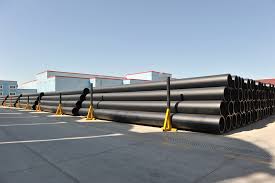Dec . 06, 2024 10:21 Back to list
PPR Pipe Solutions for Efficient Hot Water Supply in Manufacturing Facilities
The Role of PPR Pipes in Hot Water Supply Systems for Factories
In modern industrial environments, the reliability and efficiency of water supply systems are vital for maintaining operational continuity. Among the various piping materials available, Polypropylene Random Copolymer (PPR) pipes have emerged as a popular choice, especially for hot water supply applications. This article discusses the importance of PPR pipes, their benefits, and their suitability for factories that require efficient hot water supply systems.
Understanding PPR Pipes
PPR pipes are made from a thermoplastic polymer, specifically polypropylene. These pipes are known for their durability, resistance to corrosion, and ability to handle high temperatures and pressures. The random copolymer structure allows for enhanced flexibility and impact resistance compared to other types of polypropylene. This makes PPR pipes especially useful in industrial settings where hot water supply is critical, such as in manufacturing, food processing, and chemical industries.
Benefits of PPR Pipes for Hot Water Supply
1. Temperature Resistance One of the most significant advantages of PPR pipes is their ability to withstand high temperatures. They can typically handle temperatures up to 95°C (203°F) continuously, making them ideal for hot water applications. This resistance significantly reduces the risk of pipe failure due to thermal expansion or overheating, which can lead to costly downtime in factories.
2. Corrosion Resistance Unlike metal pipes, PPR pipes do not corrode over time. This feature is particularly beneficial in industrial environments where the pipes may be exposed to various chemicals or water impurities. The absence of corrosion leads to a longer lifespan for the piping system, reducing maintenance costs and extending replacement intervals.
3. Low Thermal Conductivity PPR pipes have low thermal conductivity, which means they can maintain the temperature of the hot water as it travels through the system. This property helps to reduce energy losses and enhances the overall efficiency of the hot water supply system, leading to lower energy bills for factories.
4. Ease of Installation PPR pipes are lightweight and easy to handle, making the installation process quicker and more efficient. They can be joined using various methods such as fusion welding, which creates a strong, leak-proof connection. This ease of installation results in reduced labor costs and minimizes the possibility of installation errors.
5. Hygienic Properties PPR pipes are non-toxic and do not leach harmful substances into the water supply. This characteristic is crucial in industries where water quality is paramount, such as in the food and beverage sector. The hygienic nature of PPR does not compromise the safety of the hot water used in processing and production.
ppr pipe for hot water supply factories

6. Environmental Sustainability PPR pipes are recyclable and have a lower environmental impact than many alternatives. Factories increasingly prioritize sustainable practices, and the use of recyclable materials in their infrastructure supports these initiatives. The longevity of PPR pipes also contributes to reduced waste over time.
Applications in Factories
In industrial settings, PPR pipes are widely used for a range of applications
- Hot Water Distribution They serve as the primary plumbing material for distributing hot water throughout the plant. Their temperature resistance ensures a steady supply for various processes.
- Heating Systems Many factories utilize hot water for heating purposes, whether for space heating or in process heating. PPR pipes can efficiently handle the demands of such systems.
- Food Processing Due to their hygienic properties, PPR pipes are commonly used in food processing plants, where maintaining high standards of hygiene is critical.
- Chemical Processing The resistance to chemicals and hot temperatures makes PPR pipes suitable for transporting various industrial fluids in chemical manufacturing.
Conclusion
PPR pipes represent a reliable and efficient solution for hot water supply systems in factories. Their numerous advantages, including temperature resistance, corrosion resistance, and sustainability, make them an ideal choice for a wide range of industrial applications. As manufacturers continue to prioritize efficiency and safety, the adoption of PPR piping systems is likely to increase, reinforcing their essential role in modern industrial infrastructure. Investing in PPR technology not only enhances operational efficiency but also aligns with sustainable practices in today’s manufacturing landscape.
-
High-Quality PVC Borehole Pipes Durable & Versatile Pipe Solutions
NewsJul.08,2025
-
High-Quality PVC Perforated Pipes for Efficient Drainage Leading Manufacturers & Factories
NewsJul.08,2025
-
High-Quality PVC Borehole Pipes Durable Pipe Solutions by Leading Manufacturer
NewsJul.08,2025
-
High-Quality PVC Borehole Pipes Reliable PVC Pipe Manufacturer Solutions
NewsJul.07,2025
-
High-Quality UPVC Drain Pipes Durable HDPE & Drain Pipe Solutions
NewsJul.07,2025
-
High-Quality Conduit Pipes & HDPE Conduit Fittings Manufacturer Reliable Factory Supply
NewsJul.06,2025

